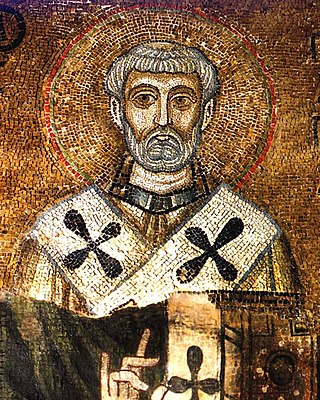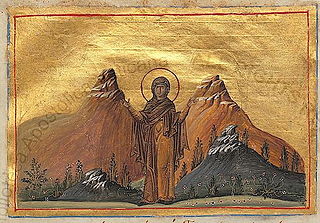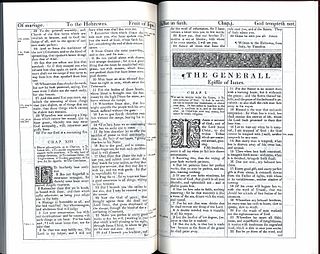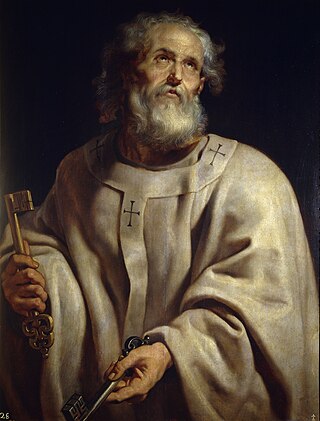
Barnabas, born Joseph (Ἰωσήφ) or Joses (Ἰωσής), was according to tradition an early Christian, one of the prominent Christian disciples in Jerusalem. According to Acts 4:36, Barnabas was a Cypriot Levite. Identified as an apostle in Acts 14:14, he and Paul the Apostle undertook missionary journeys together and defended Gentile converts against the Judaizers. They traveled together making more converts, and participated in the Council of Jerusalem. Barnabas and Paul successfully evangelized among the "God-fearing" Gentiles who attended synagogues in various Hellenized cities of Anatolia.
The New Testament (NT) is the second division of the Christian biblical canon. It discusses the teachings and person of Jesus, as well as events relating to first-century Christianity. The New Testament's background, the first division of the Christian Bible, is called the Old Testament, which is based primarily upon the Hebrew Bible; together they are regarded as Sacred Scripture by Christians.

Timothy or Timothy of Ephesus was an early Christian evangelist and the first Christian bishop of Ephesus, who tradition relates died around the year AD 97.

Clement of Rome, also known as Pope Clement I, was the bishop of Rome in the late first century AD. He is considered to be the first of the Apostolic Fathers of the Church, and a leading member of the Church in Rome in the late 1st century.

The New Testament apocrypha are a number of writings by early Christians that give accounts of Jesus and his teachings, the nature of God, or the teachings of his apostles and of their lives. Some of these writings were cited as scripture by early Christians, but since the fifth century a widespread consensus has emerged limiting the New Testament to the 27 books of the modern canon. Roman Catholic, Eastern Orthodox, and Protestant churches generally do not view the New Testament apocrypha as part of the Bible.

The Acts of Peter is one of the earliest of the apocryphal Acts of the Apostles in Christianity, dating to the late 2nd century AD. The majority of the text has survived only in the Latin translation of the Codex Vercellensis, under the title Actus Petri cum Simone. It is notable for a description of a miracle contest between Saint Peter and Simon Magus, the first record of the tradition that Saint Peter was crucified head-down, and as the origin of the saying Quo vadis?

The Third Epistle to the Corinthians is an early Christian text written by an unknown author claiming to be Paul the Apostle. It is also found in the Acts of Paul, and was framed as Paul's response to a letter of the Corinthians to Paul. The earliest extant copy is Papyrus Bodmer X, dating to the third century. Originally written in Koine Greek, the letter survives in Greek, Coptic, Latin, and Armenian manuscripts.

The Pauline epistles are the thirteen books in the New Testament traditionally attributed to Paul the Apostle.
The Berlin Codex, given the accession number Papyrus Berolinensis 8502, is a Coptic manuscript from the 5th century CE, unearthed in Akhmim, Egypt. In Cairo, in January 1896, Carl Reinhardt bought the codex, which had been recently discovered, wrapped in feathers, in a niche in a wall at a Christian burial site. It was a papyrus bound book, dating to early 5th century that was written in Sahidic dialect of Coptic, which was in common use in Egypt during that time.

Thecla was a saint of the early Christian Church, and a reported follower of Paul the Apostle. The earliest record of her life comes from the ancient apocryphal Acts of Paul and Thecla.

The Acts of Paul and Thecla is an apocryphal text describing Paul the Apostle's influence on a young virgin named Thecla. It is one of the writings of the New Testament apocrypha. Edgar J. Goodspeed called it a "religious romance".

The Correspondence ofPaul and Seneca, also known as the Letters of Paul and Seneca or Epistle to Seneca the Younger, is a collection of letters claiming to be between Paul the Apostle and Seneca the Younger. There are 8 epistles from Seneca, and 6 replies from Paul. They were purportedly authored from 58–64 CE during the reign of Roman Emperor Nero, but appear to have actually been written in the middle of the fourth century. Until the Renaissance, the epistles were seen as genuine, but scholars began to critically examine them in the 15th century, and today they are held to be inauthentic forgeries.

The Acts of Peter and Paul is a pseudepigraphical 5th century Christian text of the genre Acts of the Apostles. An alternate version exists, known as the Passion of Peter and Paul, with variances in the introductory part of the text. Some versions have been written by a certain Marcellus, thus the anonymous author, of whom nothing further is known and is sometimes referred to as pseudo-Marcellus. The intended Marcellus is doubtless he who after the martyrdom takes the lead in burying St. Peter "near the Naumachia in the place called the Vatican."
Antilegomena are written texts whose authenticity or value is disputed. Eusebius in his Church History used the term for those Christian scriptures that were "disputed", literally "spoken against", in Early Christianity before the closure of the New Testament canon.
The Lost Books of the Bible and the Forgotten Books of Eden (1926) is a collection of 17th-century and 18th-century English translations of some Old Testament Pseudepigrapha and New Testament Apocrypha, some of which were assembled in the 1820s, and then republished with the current title in 1926.

The Acts of the Apostles is a genre of early Christian literature, recounting the lives and works of the apostles of Jesus. The Acts are important for many reasons, one of them being the concept of apostolic succession. They also provide insight into the valuation of "missionary activities among the exotic races," since some of them feature missionary work done among, for instance, the Cynocephaly.

The Epistle to the Hebrews of the Christian Bible is one of the New Testament books whose canonicity was disputed. Traditionally, Paul the Apostle was thought to be the author. However, since the third century this has been questioned, and the consensus among most modern scholars is that the author is unknown.

Saint Peter, also known as Peter the Apostle, Simon Peter, Simeon, Simon, or Cephas, was one of the Twelve Apostles of Jesus Christ and one of the first leaders of the early Christian Church. He appears repeatedly and prominently in all four New Testament gospels as well as the Acts of the Apostles. Catholic tradition accredits Peter as the first bishop of Rome—or pope—and also as the first bishop of Antioch.

The Epistle of Pseudo-Titus is a letter attributed to Titus, a companion of Paul of Tarsus, to an unidentified ascetic community of Christian men and women. It commends the life of chastity and condemns all sexual activity, even that within marriage, as sinful. The epistle is classified under the Apocryphal New Testament and survives only in the Codex Burchardi, an eighth-century Latin manuscript, discovered in 1896 among the homilies of Caesarius of Arles. The Latin epistle contains many solecisms which originated with an author who lacked proficiency with Latin and Greek. The origins of the epistle remain unclear, however, it contains strong features of encratism. It may have connections with the Priscillianist movement in fifth century Spain.
Carl Schmidt was a German Coptologist. He made editions of various Coptic texts, and was active in Egypt in purchasing papyri for German universities. He also assisted Sir Chester Beatty in his papyri purchases.











